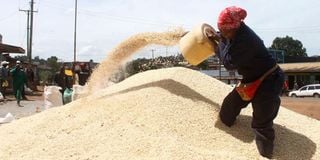Consumer relief as maize prices ease on harvesting

Maize prices in major markets have eased due to a steady stream of supply of the staple following onset of the harvesting season.
Maize prices in major markets have eased due to a steady stream of supply of the staple following onset of the harvesting season in some parts of the country.
Harvesting season in the warmer, low-altitude counties of Western, South Rift, and Nyanza usually runs from July to September, while the cooler, high-altitude regions especially in the North Rift harvest runs between October to December.
Real-time data from the Kenya Agricultural Market Information System (KAMIS), a State portal run by the Ministry of Agriculture, shows prices of the product have eased in most of the major markets but was unchanged in key outlets in some counties. In Gikomba, a leading market in Nairobi, the price of a kilogramme of maize retailed at Sh55 on Wednesday, a 10 per cent drop compared to a price of Sh60 on a similar date last month.
In Kibuye, the largest market in Kisumu, retail prices of the grain fell from Sh50 per kilogramme to Sh45 during the same period.
However, not all counties are enjoying the decline in maize prices. In Mghange, a market in Taita Taveta, prices have remained stagnant at Sh45 per kilogramme.
According to experts, maize prices remain high in coastal counties, which received lower rainfall compared to other regions during the planting season. “Most of the maize here has been coming in from Tanzania. Traders have also been incurring high fuel costs to transport maize from other regions leading to the prices remaining high,” said Dr Bernard Korir who spoke on phone from Taita Taveta.
Dr Korir is a scientist at the Kenya Agricultural and Livestock Research Organization (Kalro).
He said counties in the country’s breadbasket of Rift Valley and Western are making bumper harvests due to the sufficient rains they received this year.
“Prices in places such as Eldoret, Kitale, and Narok have gone down because recently harvested maize has started to hit the market. The yields were very good this year because of the rains and availability of fertiliser,” said Dr Korir.
Maize is by far the most-grown food crop in Kenya.
Demand has, however, been increasing rapidly due to the fast-growing population.
This has resulted in the local output of the cereal struggling to meet demand, thus forcing the country to dip into the international markets to plug the deficit.
In 2023, the quantity of maize sold increased by 24 percent from 149,500 tonnes in 2022 to 185,400 tonnes, according to the Economic Survey, 2024.
The government is betting on the continued rollout of the fertilizer subsidy to increase production.





